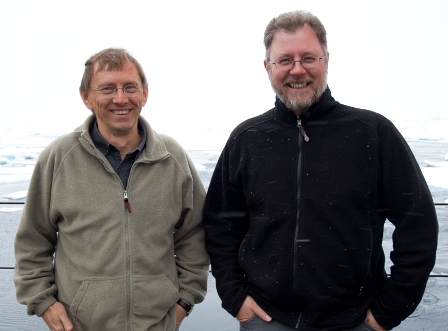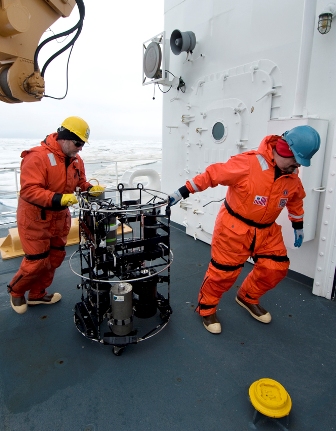From: Matt Mills, Stanford University
Matt Mills samples water from the CTD rosette. (Photo by Haley Smith Kingsland)
It’s 3:45 a.m. and I’m just climbing into my bunk. I’ve been on shift since 3:00 p.m. and I’m a little tired. I’ll sleep until somebody pages me for another station or, more humanely, the On-Ice Brief sometime around 9:00 a.m. this morning.
It’s particularly busy these days because we’re sampling stations both in the sea ice and in the open water next to the ice. At almost all stations, we collect water and/or sea ice from different depths. We’re mainly interested in the tiny one-celled algae that live either in the ice or in the water under and next to the ice.
When I say we’re interested in algae, I mean we want to know how much algae exist, how fast they’re growing, what they’re made of, and what their environment is like. In some ways, algae are much like us in that they are made up mostly of carbon, nitrogen, and phosphorus, and it’s useful to know how much of each of these elements they contain under different environmental conditions. To do that, we also measure light intensity, temperature, nutrient content, and the saltiness of their environment. By measuring all these things (and many more!) at many different stations, we hope patterns will emerge to help us understand how the environment controls the growth of algae here in the Arctic.
Sampling. What does that mean?
In the sea ice, it means drilling into the ice and extracting an ice core that we cut into four or five 8-inch pieces so they fit snugly into our sample bottles.
In the water, things are much more high-tech. At each station, we stop the ship and slowly let a metal frame called a rosette sink from the surface to the bottom of the ocean while suspended from a metal cable. Our rosette holds twelve 30-liter bottles and an instrument package called a CTD (it measures Conductivity— a proxy for saltiness—Temperature, and Depth). There are other instruments on the rosette that tell us how many particles, including algae, are in the water. On the way down, all bottles on the rosette stay open and the CDT and other instruments record data that are sent back to the ship’s computer where myself and other scientists can see, in real time, the physical characteristics of the water and where the algae are located. Then, before the rosette begins its ascent, I quickly decide with input from several other scientists what depths we want to close the 12 bottles to collect our water samples.
This is usually pretty easy because we have standard depths where we always collect water. Likewise, we are now in a routine so I pretty much know what everybody needs. However, sometimes the water looks particularly interesting. Maybe there are unusual layers of salinity, temperature, or algal abundance. Then we mix it up on the fly with people changing their plan as they see the data flash on the screen.
“Can you close my bottles at the bottom, at the surface, and at that chlorophyll maximum right at 23 meters?”
“Wait, our surface bottles have to be closed at 4 meters not 2!”
It’s a pressure-packed moment because I have to quickly calculate and recalculate how many bottles to close at each new depth so that everybody gets his or her water. We have to get it right because once the rosette begins its slow rise back to the surface, we can’t send it back down, and scientists do not like it when they don’t get their water.
Luckily, we have a great group here that helps me make these decisions and gives me enough time to get it right. There have only been a few mistakes. Eventually, the rosette is brought to the surface with all the bottles closed at the correct depths. Now we can sample!
Sampling the rosette is not a free-for-all, although it may look like one. There’s a specific order to who samples first and who samples last. First, Susan collects a sample for oxygen. Then Marlene and Mike get water to measure its carbon content. Scott gets water for nutrients and salts. Karen samples for oxygen isotopes, then Atsushi his CDOM (kind of like the stuff that gives tea its brown color), and Eva her bacteria sample. Last are the “water hogs” like Cedric (for chemicals leaking into the ocean from the land) and The Arrigo Group (Kate, Molly, Zach, and Gert, as well as Elliot, whom we adopted from another lab group). The water hogs basically drain the remaining bottles, taking anywhere from 15 to 30 liters for their measurements.
Now the real fun begins. OK, not really. Once we have our water, we have to pump vast quantities of it through little filters that trap all the particles, which are mostly algae, for different analyses. If things go fast, this can be done in two hours, but when algae are scarce or are particularly “snotty” — some produce lots of mucus — things go slow and we may filter water for four hours. Ughhhh! Have you ever watched water drip? That is basically the job!
After the filtering is done, we freeze some filters, dry others, refrigerate some, and immediately process others. Then we clean up, prepare for the next station, have some coffee or a meal, and hopefully, steal a moment to go on deck to breathe in the cold Arctic air or try to find a polar bear or walrus on the surrounding ice.
My pager just went off. I guess we are at another station.
Gert van Dijken, Zach Brown, Christie Wood, and Matt Mills sample water from under the sea ice. (Photo by Haley Smith Kingsland)

 Matt_Zach2.jpg)
 Christie.jpg)
 Luke IcePro.jpg)
 Profileer.jpg)
 Karen_Christie.jpg)
 Three Scientists.jpg)
 Ruzica.jpg)










